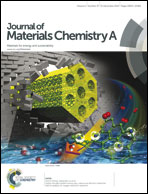New CuxSy/nanoporous carbon composites as efficient oxygen reduction catalysts in alkaline medium†
Abstract
A new hybrid catalyst containing crystalline copper-based phases, CuxSy, CuO, Cu4(OH)6SO4 and S-doped nanoporous polymer-derived carbon was obtained by carbonization of the physical mixture of Cu–BTC (MOF)/graphite oxide composites with a commodity polymer (poly(4-styrenesulfonic acid-co-maleic acid) sodium salt). The resulting highly porous composites with a high degree of mesoporosity compared to the initial carbon showed a marked electrocatalytic activity for oxygen reduction reaction (ORR) in alkaline medium. The current density was higher than that on commonly used platinum modified carbon and the number of electron transfer (∼4) indicated the high efficiency for ORR. This was accompanied by a high tolerance to methanol oxidation and superior long-term stability after 1500 potential cycles. The extensive surface characterization (XPS, XRD, SEM/EDX, HR-TEM and nitrogen adsorption) indicated the fast O2 adsorption and charge transfer owing to the surface hydrophobicity, small pores, and conductivity. The synergistic effect of crystalline copper-based phases and S-doped carbon leads to a high ORR activity and high kinetic current densities.


 Please wait while we load your content...
Please wait while we load your content...